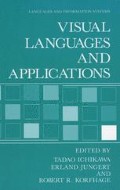Abstract
In this chapter, a new approach for knowledge-based visual information system design based upon a spatial knowledge structure will be presented. In this spatial knowledge structure, the object-oriented data structure for image encoding is the run-length code (RLG). The technique of symbolic projection is used to generate descriptions of symbolic pictures. The technique of orthogonal relationships is then applied to identify basic spatial relations. With the use of this technique, objects with complex shapes can be segmented. Production rules can then be applied to derive more complex spatial relations from the symbolic projections.
Access this chapter
Tax calculation will be finalised at checkout
Purchases are for personal use only
Preview
Unable to display preview. Download preview PDF.
References
E. Jungert, Run length code as an object-oriented spatial data structure, Proceedings of IEEE Workshop on Languages for Automation, Singapore, August 27–29, 1986.
S. K. Chang, Q. Y. Shi, and C. W. Yan, Iconic indexing by 2D strings, Proceedings of IEEE Workshop on Visual Languages, Dallas, Texas, June 25–27, 1986.
D. A. Waterman, A Guide to Expert Systems, Addison-Wesley, Reading, Massachusetts, 1986.
T. Lozano-Perez, Spatial planning a configuration space approach, IEEE Trans. Comput. C-32(2), 108–120 (1983).
E. K. Wong and K. S. Fu, A hierarchical orthogonal space approach to three-dimensional path planning, IEEE Trans. Robotics Automation RA-2(1), 43–53 (1986).
Author information
Authors and Affiliations
Editor information
Editors and Affiliations
Rights and permissions
Copyright information
© 1990 Plenum Press, New York
About this chapter
Cite this chapter
Chang, SK., Jungert, E. (1990). A Spatial Knowledge Structure for Visual Information Systems. In: Ichikawa, T., Jungert, E., Korfhage, R.R. (eds) Visual Languages and Applications. Languages and Information Systems. Springer, Boston, MA. https://doi.org/10.1007/978-1-4613-0569-9_15
Download citation
DOI: https://doi.org/10.1007/978-1-4613-0569-9_15
Publisher Name: Springer, Boston, MA
Print ISBN: 978-1-4612-7871-9
Online ISBN: 978-1-4613-0569-9
eBook Packages: Springer Book Archive

